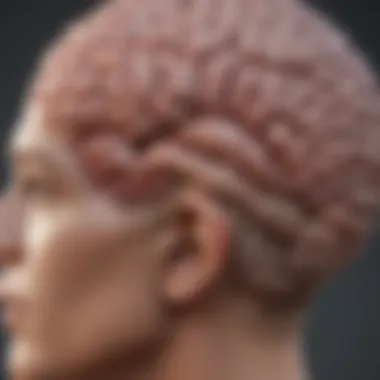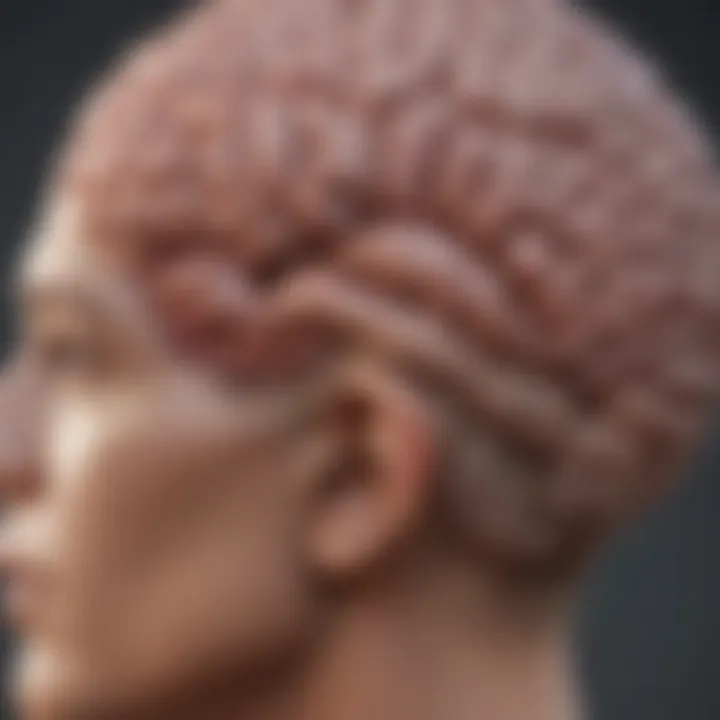Headaches and Brain Tumors: Key Insights and Warning Signs


Intro
The intricate relationship between headaches and brain tumors is a subject of both concern and curiosity for many. Headaches are one of the most prevalent medical complaints, experienced by individuals of all ages. They range from the occasional tension headache to cluster headaches that can disrupt one’s daily life. While most headaches are harmless, understanding when they may denote a more serious underlying issue, such as a brain tumor, is crucial for early intervention and treatment.
In this article, we will explore the different types of headaches, their symptoms, and the factors that could signal a more significant neurological condition. By highlighting the nature of headaches alongside insights into various types of brain tumors, we aim to help you recognize warning signs and know when to seek medical advice. Whether you are a concerned parent, an individual dealing with persistent headaches, or simply someone interested in wellness, this guide serves as an informative resource on this important health matter.
Wellness
Physical Health
When it comes to headaches, physical health plays a substantial role. Chronic pain, especially in headache form, can be a symptom that something more serious is brewing. The body provides us with various signals, and learning to interpret these can be invaluable.
Not every nagging headache is indicative of a brain tumor. However, factors such as sudden changes in headache patterns, intensity, or associated symptoms like nausea and visual disturbances should prompt a visit to a healthcare professional.
Several headache types are associated with physical health issues:
- Tension Headaches: Often caused by stress or muscle strain, these are the most common and usually not serious.
- Migraine: These can be debilitating, sometimes accompanied by visual auras.
- Cluster Headaches: Though less common, these are extremely painful and can occur in cyclical patterns.
Understanding the nature of your headache is key.
Mental Health
Mental health cannot be overlooked when dissecting headache causes. Stress, anxiety, and depression have been linked to various types of headaches, contributing to their frequency and intensity. An interesting aspect is that headaches themselves can further complicate mental well-being by causing distress and impairment.
Additionally, the relationship between migraines and anxiety is notable. Some studies indicate that individuals with higher anxiety levels might experience migraines more frequently. Keeping mental health in check can frequently alleviate headache burdens as well. It's a two-way street: a headache can provoke mental strain, while poor mental health can lead to more headaches.
Nutrition and Diet
What we put in our bodies affects our overall health, and headaches are no exception. Certain foods can act as triggers for various headache types. Common culprits include:
- Aged cheeses
- Processed meats
- Alcohol, particularly red wine
- Food additives like MSG
By keeping a diary of food intake and headache incidents, individuals can identify and eliminate potential triggers from their diets. This proactive approach not only aids in headache management but can also improve overall health.
Fitness and Exercise
Physical activity is often recommended as a way to alleviate headache symptoms. Regular exercise can enhance blood circulation and alleviate tension that contributes to headaches. Activities like yoga and stretching can also help in reducing stress, which is a common headache trigger.
Nonetheless, it’s crucial to find a balance. Overexertion can sometimes lead to headaches. Therefore, it’s advisable to start with moderate activities and gradually build up, ensuring any exercise regimen is tailored to personal comfort and capability.
"Taking care of your body is a form of self-respect."
In summary, understanding the interplay between wellness and headaches paves the way for recognizing when a visit to a physician is not only necessary but potentially lifesaving.
Prelims to Headaches
Headaches are a universal affliction, seen as simple nuisances by some and dire warning signals by others. In the landscape of neurological conditions, understanding headaches is crucial, especially when it comes to distinguishing benign occurrences from those that might be indicative of something far more serious, like a brain tumor. This article aims to peel back the layers of this relationship, shedding light on various headache types and their frequency, alongside how they may relate to sinister underlying conditions.
Recognizing the nuances of headaches is not just about alleviating discomfort; it's about understanding what our bodies are trying to communicate. The informative journey we embark upon here will guide readers through essential distinctions that can empower proactive health decisions.
Types of Headaches
When we talk about headaches, it’s essential to understand that not all headaches are created equal. They can be broadly categorized into two main types—primary and secondary headaches. Each type carries its own unique characteristics, significance, and implications for treatment.
Primary Headaches
Primary headaches involve discomfort that's not tied to any underlying condition. These headaches are the condition themselves, and they are primarily categorized into migraines, tension-type headaches, and cluster headaches. The notable feature of primary headaches is that they can occur independently from any other health issues, representing a direct reaction from the nervous system.
- Migraines: Often, they come with intense throbbing pain, sensitivity to sound or light, and can last for hours, or even days.
- Tension-type headaches: These might feel like a tight band around your head, presenting mild to moderate pain.
- Cluster headaches: These are rarer, marked by agonizing pain around one eye, occurring in clusters over a period.
This classification is beneficial for our discussion because it helps to isolate headaches caused by other factors, judging their urgency in a clinical context. Primary headaches can lead to lifestyle adjustments, while also serving as important markers for overall health trends in individuals.
Secondary Headaches
On the other hand, secondary headaches are symptomatic of another condition. They can appear as a warning sign from the body that something more serious is at play.
- Types of secondary headaches can include those triggered by dehydration, high blood pressure, sinus infections, or, notably, brain tumors.
- Key characteristic: These headaches often arise in conjunction with other symptoms, making it essential to assess the context in which they occur.
Here’s where secondary headaches present an unattractive double-edged sword—they might alert you to a need for medical attention, yet they can also lead to increased anxiety when the cause is unknown. They remind us that our bodies often have a compelling way of signaling when something’s amiss.
Prevalence of Headaches in the Population
Headaches are not merely personal woes; they are a significant public health concern. It is estimated that a considerable chunk of the population experiences headaches at some point in their lives. For many adults, regular headache occurrences have become par for the course.
- Statistics indicate that around 50% of adults worldwide have had a headache in the last year.
- The impact is particularly profound among women and individuals in middle age, with socio-economic factors compounding the issue.


The proliferation of headaches underscores an important aspect of this discussion. With such a high prevalence, distinguishing concerning symptoms from typical headache triggers becomes pivotal in understanding their connection to serious health issues like brain tumors. The more we identify patterns, the better equipped we are to tackle what our headaches could signal.
Headaches as a Symptom
Headaches can serve as more than just a nuisance—sometimes, they are a significant signal that something might be amiss within the body. Understanding headaches as symptoms is crucial, particularly when we are looking at potential connections to more serious conditions like brain tumors. This section will shed light on various aspects of headaches as symptoms, emphasizing the characteristics of their duration, intensity, and accompanying signs. Recognizing these factors can not only help in identifying the type of headache one is experiencing but can also guide individuals to seek appropriate medical intervention if needed.
Understanding Headache Symptoms
Duration and Intensity
The duration and intensity of a headache play an important role in determining its nature. Short-lived, intense headaches may indicate a migraine or cluster headache, which are known for their debilitating effects. In contrast, a headache that lingers for days but is more mild could signal tension-type headaches or perhaps even a more serious condition.
A key characteristic of duration is its variability—a migraine attack might last anywhere from a few hours to more than three days, while tension headaches could hang around for days without much change in severity. Understanding how long a headache lasts can aid healthcare providers in narrowing down potential causes. Intensely painful headaches that appear suddenly can warrant immediate medical evaluation.
The unique feature of duration and intensity is that they can also evolve. For instance, a tension headache may begin lightly and then increase in intensity, notably altering the interpretation of symptoms over time. Recognizing this aspect can help prioritize medical attention effectively.
Accompanying Symptoms
Accompanying symptoms can serve as critical clues when assessing headaches. Signs like nausea, light sensitivity, or visual disturbances may accompany migraines, while tension headaches might bring about soreness in the neck or shoulders. These additional characteristics not only inform the headache’s classification but also its potential seriousness.
The presence of accompanying symptoms is significant as they can provide context. For instance, if a headache presents alongside neurological changes, it might indeed signify a serious concern such as increased intracranial pressure. Understanding accompanying symptoms can also clarify if the headache is primary or secondary in nature.
What stands out here is that these additional symptoms can vary widely, reflecting personal health, stress levels, or even environmental factors. This variability allows individuals a broader understanding of what their headaches might indicate, prompting further investigation if patterns emerge.
When to Seek Medical Attention
Warning Signs
Being equipped with knowledge of warning signs is critical for effective symptom management. Some red flags include sudden onset headaches, headaches that wake a person from sleep, or headaches that worsen significantly over time. These could potentially signal serious conditions, including those linked to brain tumors.
Highlighting specific characteristics of warning signs is essential, as they often serve as a guideline for urgency in seeking medical help. The sudden emergence of a severe headache, often described as the worst in one’s life, can indicate life-threatening conditions like a hemorrhagic stroke. Understanding these indicators can make a significant difference in outcomes.
The unique feature of warning signs is their potential duality; they can be both specific and nonspecific depending on the context. This means a nuanced understanding of what constitutes a warning sign is necessary for informed medical decisions.
Frequency and Patterns
Another factor to consider is the frequency and patterns of headaches. Regular occurrences may signal chronic conditions such as migraines or tension-type headaches. The pattern can often offer insights into triggers or suggest the need for comprehensive evaluations. For example, if headaches occur more than twice a week, it is wise to consult a healthcare professional.
Describing frequency highlights its key characteristic—consistency. If headaches follow a predictable pattern, it may simplify diagnosis and treatment. This is a beneficial aspect for both patients and healthcare providers, as it can create a structured approach to management.
In summary, the frequency and patterns of headaches can act as valuable indicators. They not only reveal underlying conditions but also help establish a management plan that considers the individual’s specific circumstances.
Brain Tumors: An Overview
The topic of brain tumors holds significant weight in understanding the connection between persistent headaches and more serious health conditions. A clear grasp of brain tumors is essential for both medical professionals and the general public. Failing to recognize the symptoms or misinterpreting them as simple headaches can delay crucial diagnosis and treatment.
Types of Brain Tumors
Benign vs. Malignant
Understanding the difference between benign and malignant tumors is pivotal. Benign tumors are non-cancerous growths that generally grow slowly and do not invade nearby tissues. Patients may feel a sense of relief knowing these tumors are not life-threatening, but they can still cause significant problems depending on their location and size.
On the other hand, malignant tumors are cancerous and may spread to other areas of the brain or body. These tumors require prompt intervention, often involving chemotherapy or surgery. The distinguishing characteristic is crucial: benign tumors, while less aggressive, can still lead to symptoms that mimic those of malignant tumors. This aspect makes them a relevant subject in medical discussions, particularly in the context of headache analysis.
- Advantages/Disadvantages: The advantage of recognizing benign conditions is that they can sometimes be monitored without aggressive treatment. However, mistaking them for something harmless might lead individuals to overlook evolving symptoms that could signify a malignant process.
Common Brain Tumor Types
There are various types of brain tumors, some more prevalent than others. Among the most common types are gliomas, meningiomas, and pituitary tumors. Each type comes with its own unique characteristics and manifestations:
- Gliomas originate from glial cells and can be either benign or malignant, with varying impacts depending on their specific subtype.
- Meningiomas are generally benign and form in the membranes surrounding the brain, usually growing slowly.
- Pituitary tumors can affect hormonal balance, leading to a range of symptoms from headaches to changes in vision.
Recognizing common tumor types is vital for early diagnosis. The earlier a brain tumor is identified, the better the chances of a favorable outcome. This context highlights the importance of ongoing medical education.
Symptoms of Brain Tumors
Headaches
Headaches can be one of the first signs of a brain tumor. They differ from typical headaches in their persistent nature and intensity. A key characteristic of tumor-related headaches is their tendency to worsen over time, becoming a daily burden rather than an occasional inconvenience. Patients often describe these headaches as different from their usual patterns, sometimes noting that they occur in a new location or at different times of the day.
- Unique Features: This type of headache may be accompanied by other symptoms, which may help distinguish it from common tension or migraine headaches.
Nausea and Vomiting
Nausea and vomiting often accompany brain tumros, particularly in cases where increased intracranial pressure is involved. These symptoms are significant because they can develop quite suddenly.
Patients often report a feeling of unwellness that doesn’t respond to normal remedies or medication. Having nausea and vomiting as symptoms pushes the importance of seeking timely medical assessment.


Cognitive Changes
Changes in cognition can also signify underlying brain issues, including tumors. This might manifest as memory loss, confusion, or difficulty concentrating. Identifying these changes is critical because they can directly affect daily living and quality of life. Noticing cognitive shifts may prompt individuals to seek help sooner rather than later, leading potentially to an earlier diagnosis.
- Significance: In the context of this article, recognizing cognitive changes could be a wake-up call for individuals or families to investigate further medical inquiry.
It is this understanding of brain tumors and their respective symptoms that ties directly back to the larger picture: headaches as potential indicators of more serious conditions. Recognizing the nuances of these conditions can mean the difference between early intervention and delayed treatment.
The Link Between Headaches and Brain Tumors
Headaches are a common ailment, but their relationship with brain tumors is one that deserves careful consideration. Recognizing this connection can have profound implications for diagnosis and treatment. Headaches may prompt an examination into underlying conditions that could be far more serious than just a simple tension headache or migraine. This section aims to explore various facets of this link, stressing the importance of awareness and prompt medical evaluation for persistent headache symptoms.
Research Insights
Scientific Studies
Scientific studies on headaches and their connection to brain tumors should not be taken lightly. They contribute a wealth of knowledge aimed at understanding incidence rates, types of headaches, and their association with brain tumors. For instance, a well-documented study showcased that certain headache patterns significantly correlate with specific types of tumors. This provides a verifiable basis for healthcare professionals to step up investigations when a particular headache pattern emerges. These studies reveal that factors like headache duration, intensity, and accompanying symptoms can be critical indicators of underlying issues.
Moreover, the key characteristic of these scientific studies is their reliance on empirical data. They utilize rigorous methodology to derive conclusions, making them a vital tool for medical professionals. However, a disadvantage might be the general population's difficulty in accessing or understanding such studies, potentially leading to unnecessary fear or anxiety about experiencing headaches. Nevertheless, the insights derived are essential for informed clinical decisions.
Expert Opinions
Expert opinions lend a nuanced layer to the understanding of headaches in relation to brain tumors. Renowned neurologists often weigh in, emphasizing that headaches, while frequently benign, deserve diligence in assessment. The unique aspect here is that these experts not only base their views on clinical evidence but also on years of practice and patient encounters. Their testimonies often serve to unblock misconceptions and clarify the nuances that pure scientific literature might overlook.
A noteworthy benefit of expert opinions is the personalized approach to care. Doctors emphasize tailored evaluations when it comes to headaches. However, reliance on expert testimony can vary. Someone might face discrepancies in recommendations, depending on the notable expert consulted. The challenge lies in choosing credible sources while remaining open to differing views within the medical community.
Headaches as an Early Indicator
Case Studies
Examining case studies often serves as a stark reminder of how headaches can act as early indicators of serious conditions, including brain tumors. Looking into past clinical cases shows instances where patients initially dismissed their headaches, only to discover severe underlying conditions that would have benefitted from early intervention. This sets a precedent for acknowledging headache patterns as potential red flags. A compelling case involved a middle-aged individual who experienced new-onset headaches. Within weeks, further evaluation revealed a significant brain lesion, turning what appeared to be a mundane issue into a critical medical situation.
The main advantage of case studies is that they provide real-world context and insight into how symptoms can manifest differently among patients. They illustrate the importance of taking headaches seriously and encourage vigilance, especially when other symptoms are present. Of course, a downside is that individual stories cannot be generalized to the broader population, and they often vary significantly in circumstance and outcome.
Statistical Correlations
Statistical correlations have significant constraints but are indeed invaluable in studying headache phenomena. They help researchers identify trends, highlight which types of headaches are more commonly linked to brain tumors, and reveal the frequency of occurrence. For example, research can show how cluster headaches align with certain tumor forms, allowing clinicians to make data-driven assessments.
The key characteristic of utilizing statistical correlations is the ability to analyze large datasets to draw broader conclusions. However, it is essential to approach these correlations cautiously, as correlation does not imply causation. Just because one condition appears frequently with another does not mean they are inherently linked by a direct cause-effect relationship. This nuanced understanding is necessaire to raise awareness and support better medical practices.
"Recognizing a link between headache patterns and serious conditions can be life-saving; paying close attention to symptoms is crucial."
In summary, understanding the intricate relationship between headaches and brain tumors is essential not only for healthcare providers but for patients as well. Increased awareness and sharp evaluation through expert opinions, scientific studies, case studies, and statistical data can aid in recognizing the importance of addressing persistent and concerning headache symptoms. By doing so, individuals can approach their health with a sense of ownership and vigilance.
Differentiating Between Headache Types
Understanding how to differentiate between various headache types is essential for anyone dealing with persistent discomfort. This knowledge can help steer individuals toward the right treatment and potentially identify any serious underlying conditions, such as brain tumors. The significance of recognizing headache types lies in their distinct characteristics and cause, as each type demands a different approach for management and relief.
When headaches strike, whether they are sharp and debilitating or merely a dull throb, it’s crucial to assess their nature. By differentiating between headache types, individuals can discover patterns that could point to serious issues. More importantly, this awareness fosters a proactive response that can alleviate suffering and lead to effective interventions.
Migraine vs. Tension Headaches
Migraine headaches are often portrayed in a doom and gloom light—many people know someone who has suffered through the intense pain they bring. Symptoms include pounding pain, often on one side of the head along with nausea and sensitivity to light or sound. They can be preceded by auras, which are visual or sensory disturbances. Migraine sufferers might find solace in a dark room or may need relief from potent medications to manage the agonizing episodes.
On the flip side, tension headaches are usually the result of muscle contractions in the head, neck, or shoulders and they manifest as a constant dull pain. They are generally associated with stress or fatigue. Unlike migraines, they don’t typically present with other alarming symptoms. Generally, over-the-counter pain relief can address tension headaches effectively.
- Migraine Attributes:
- Tension Headache Traits:
- Pounding pain on one side.
- Accompanied by nausea and auras.
- Can last from hours to days.
- Dull, persistent ache.
- Linked to stress or posture.
- Typically short-lived and manageable.
This distinction is vital; a person experiencing migraines should seek specific interventions, while someone dealing with tension headaches may just need lifestyle adjustments.
Cluster Headaches and Their Characteristics
Cluster headaches, though less common, are notorious for their severe intensity. They occur in cycles or clusters, which can last from weeks to months, alternating with periods of remission. These headaches frequently arise at night and cause unilateral sharp pain behind the eye, accompanied by symptoms such as nasal congestion or tearing on the affected side.
The treatment for cluster headaches may differ from that of migraines or tension headaches. Finding quick relief is imperative, and many people rely on oxygen therapy or specific medications that can halt an ongoing attack. Knowing that one is experiencing cluster headaches, as opposed to migraines or tension headaches, can provide clarity and direct medical intervention more effectively.
"For headache sufferers, recognizing the type can be a game-changer in finding the right treatment and avoiding unnecessary suffering."
In summary, being attuned to the differences between various headache types equips individuals with the insight necessary to approach their symptoms comprehensively. Not only does it enhance treatment options, but it also brings peace of mind in managing a life affected by headaches.
Diagnosis and Testing


Understanding how to effectively diagnose the causes of headaches is crucial, especially when considering the potential connection with brain tumors. Diagnosis and testing serve not only to identify the underlying issue but also to distinguish between benign headaches and those that could point to more serious neurological complications. Through thorough testing processes, healthcare providers can better tailor their treatment strategies and provide the most accurate prognosis.
Medical Evaluation Process
Neurological Examination
A neurological examination is often the first step when a patient presents with persistent headaches. This type of exam assesses the nervous system's overall condition, including vision, movement, and coordination. A key characteristic of a neurological examination lies in its comprehensive nature. Doctors look for subtle signs that may indicate neurological deficits that should be further explored. The examination is beneficial as it provides immediate feedback on brain function, ensuring other serious conditions can be ruled out.
One unique feature of this examination is that it includes tests for balance and reflexes, which helps to pinpoint areas of concern. However, despite its advantages, this examination can sometimes lead to findings that may require further testing, which can be an additional source of anxiety for the patient.
Imaging Techniques
Imaging techniques such as MRI and CT scans are essential tools in diagnosing headaches that may be linked to brain tumors. The strength of imaging techniques lies in their ability to give a visual representation of the brain's structures. CT scans are often quicker and more accessible, while MRI provides detailed images, allowing for better diagnostic accuracy. These techniques are a popular choice as they significantly enhance the doctor's ability to spot abnormalities that might not be evident from a neurological examination alone.
One unique advantage of imaging techniques is their non-invasive nature, which can reduce patient discomfort. However, it’s important to note that while imaging is highly effective, there can sometimes be false positives, leading to unnecessary worry.
Identifying Non-Tumor Related Headaches
Common Triggers
Understanding common triggers for headaches plays a vital role in differentiating between them and those caused by more serious issues. Common triggers can range from stress and fatigue to hormonal changes and certain foods. Highlighting these triggers is essential as it guides patients toward lifestyle adjustments that can lessen their headache frequency and intensity.
One key characteristic of identifying common triggers is that it often involves keeping a headache diary. This process allows individuals to track patterns and recognize the circumstances surrounding their headaches, which can be a valuable resource in discussions with healthcare providers. However, this approach may sometimes lead to frustration, especially if patterns are not easily discernible.
Environmental Factors
Environmental factors can significantly influence headache occurrences, paving the way for a better understanding of what contributes to headache conditions. Factors such as weather changes, air pollution, and bright lights are notorious for triggering headaches in sensitive individuals. Recognizing these elements can be beneficial as it empowers individuals to make changes in their surroundings to reduce headache frequency.
One distinctive aspect of environmental factors is that they can often be adjusted. For example, using air purifiers or managing light exposure can lead to fewer headaches. However, the challenge is that some environmental triggers are not easily controlled, which might make it difficult for some to mitigate their headache symptoms effectively.
In summary, the process of diagnosis and testing is multi-faceted and plays a critical role in distinguishing between typical headache episodes and symptoms that may indicate a deeper issue, such as a brain tumor. By understanding both the objective processes of medical evaluation and the subjective nature of headache triggers, individuals can take a more informed approach to their health.
Treatment Options for Headaches
Understanding the avenues available for treating headaches is crucial in this discussion about their potential link to brain tumors. The right treatment can not only alleviate discomfort but also significantly improve the quality of life for individuals experiencing chronic headaches. When faced with persistent headaches, it becomes essential to explore various treatment methods, weighing their effectiveness and appropriateness based on individual circumstances.
Medication and Lifestyle Changes
In tackling headaches, medication often takes center stage. Non-prescription pain relievers like ibuprofen or acetaminophen can offer substantial relief for many individuals suffering from typical tension or mild migraine headaches. However, for those whose headaches stem from, or are exacerbated by, other underlying issues, consulting a healthcare provider becomes vital.
In more serious scenarios, such as headaches that may indicate the presence of a brain tumor, healthcare professionals might prescribe stronger medications like triptans or even preventative treatments such as beta-blockers or anticonvulsants. But, medications are not the whole picture. Lifestyle changes play a fundamental role in mitigating headache frequency and intensity.
Here are some effective lifestyle alterations to consider:
- Hydration: Dehydration can be a sneaky headache trigger. Drinking enough water each day can make a big difference.
- Regular Sleep Patterns: Establishing a regular sleep schedule often helps to stabilize headache occurrences. Maintaining consistency in sleep, even on weekends, keeps headaches at bay for some.
- Diet Adjustments: Certain foods and drinks can trigger headaches. Keeping a food diary can help identify patterns and reduce intake of headache-inducing items.
- Stress Management: Techniques such as yoga, meditation, or even simple breathing exercises can be particularly beneficial. Finding ways to unwind in today's fast-paced world is invaluable.
- Regular Exercise: Engaging in regular physical activity has been known to diminish both the frequency and severity of headaches. Aim for moderate exercise, but always check with a doctor before starting any routine.
Ultimately, the combination of medication and lifestyle changes presents a powerful one-two punch against recurrent headaches. A thoughtful approach tailored to each individual’s unique experience can yield significant results.
When to Consider Surgical Intervention
Surgical intervention becomes a consideration in specific cases when headaches persist despite extensive medical management. It’s not a decision to be made lightly—surgery typically comes into play when headaches are caused by structural issues within the brain, such as tumors or vascular malformations.
Persistent headaches might be a sign to evaluate further with imaging tests. Often, if a tumor or another serious issue is identified, surgery could be essential not just for headache relief, but for overall health. Some potential scenarios warranting surgical discussion include:
- Tumor Removal: If imaging shows a tumor contributing to headache pain, surgeons may look into removing it.
- Shunt Placement: In cases where headaches relate to increased intracranial pressure, placing a shunt might relieve symptoms.
- Decompressive Surgery: For specific structural issues, such as chiari malformations, surgery might be employed to create more space within the cranial cavity.
"When it comes to surgeries, it's crucial for patients to thoroughly discuss the risks and benefits with their healthcare provider. Making an informed decision can be life-changing."
Surgery isn't suitable for everyone, and a thorough evaluation by a neurologist or neurosurgeon helps ascertain whether it's the right choice. Each case is different, and a comprehensive approach, including medication and potential surgery, allows for optimal headache management.
In the nuanced discussion of headaches and their connection to brain tumors, understanding these treatment options arms patients with knowledge to navigate their symptoms effectively.
End and Recommendations
In closing, understanding the intricate relationship between headaches and brain tumors is crucial for recognizing symptoms that may initially seem benign but could signal something more serious. This article underscores the necessity of paying attention to persistent headaches, particularly if they exhibit unusual characteristics or are accompanied by other troubling signs. Early recognition of symptoms plays a pivotal role in not only alleviating immediate discomfort but also in paving the way for timely intervention when necessary.
Recognizing Symptoms Early
Being vigilant about headache symptoms can make all the difference. Symptoms like a sudden onset of severe headache, changes in pattern, or headaches that worsen over time should not be brushed off. Individuals are encouraged to ask themselves questions:
- Is this headaches different from what I usually experience?
- Are there additional symptoms such as visual disturbances, balance issues, or cognitive changes?
It’s important to note that some headaches may begin subtly but can progress quickly, becoming debilitating. Keeping a headache diary can help track symptoms over time, providing valuable information to healthcare providers. This method allows for a clearer pattern recognition, which is essential when seeking medical advice.
Importance of Regular Medical Check-ups
Regular medical check-ups are pivotal for overall health, particularly when it comes to managing chronic conditions like headaches. These visits can act as a preventative measure, allowing doctors to catch any potential issues before they escalate. Moreover, during regular assessments, a healthcare professional can offer recommendations tailored to individual health needs, which is a proactive step towards maintaining well-being.
Some key points to consider regarding regular check-ups include:
- History Review: Discussing the frequency and type of headaches experienced during appointments creates an opportunity for pattern recognition and critical evaluation.
- Risk Assessment: The doctor may assess any lifestyle factors or family histories that elevate the risk for serious conditions, including brain tumors.
- Tailored Advice: Regular consultations may lead to personalized recommendations, from lifestyle changes to medications that can improve outcomes.
In summary, recognizing symptoms early and maintaining routine medical evaluations forms the foundation of proactive health management. Addressing headaches with awareness and diligence can significantly improve one’s quality of life, leading to quicker resolutions and better health outcomes.



